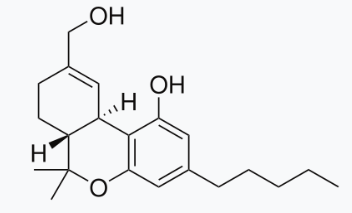Toxicology Exam 3
1/77
There's no tags or description
Looks like no tags are added yet.
Name | Mastery | Learn | Test | Matching | Spaced |
|---|
No study sessions yet.
78 Terms
What is the name of the plant from which cocaine is extracted?
Erythroxylon Coca
Under the Controlled Substances Act of 1970, what class do amphetamines fall under?
Class II
Name the forms of cocaine
Hydrochloride Salt (purity >50%)
Crack
What form of cocaine is crack?
Crack is a freebase form of cocaine
How is crack prepared?
Prepared by adding baking soda to aqueous cocaine HCl and heating it to remove water. After heating, the mixture is cooled and filtered. The freebase cocaine precipitates into small pellets that can be smoked in a crack pipe.
With structures, what is the complete metabolic pathway of cocaine to benzoylecgonine, ecgonine methyl ester, and cocaethylene?
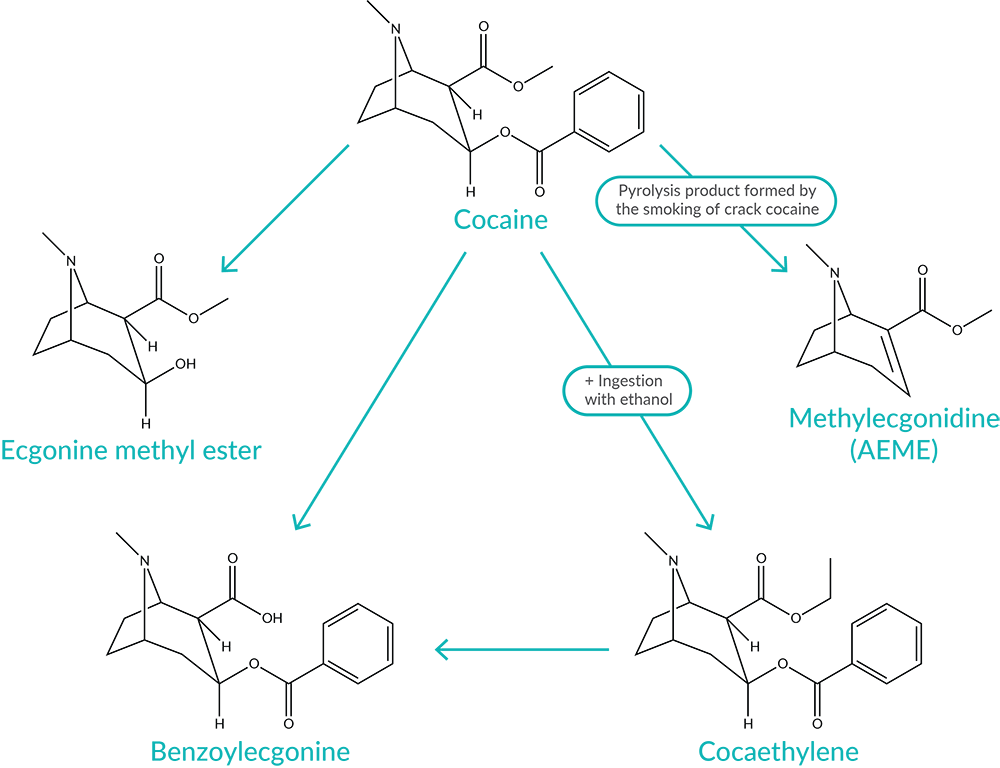
What receptors does cocaine mediate its activity through?
Norepinephrine and dopamine
Name at least three effects of cocaine that are mediated by dopamine.
euphoria
psychic energy
heightened sexual excitement
self-confidence
paranoia
hallucinations
dysphoria
Name at least three effects of cocaine that are mediated by norepinephrine.
mydriasis
vasoconstriction
hypertension
tachycardia
tachypnea
What is the pharmacodynamic mechanism of action of cocaine on a dopaminergic nerve terminal?
Cocaine prevents the reuptake of dopamine into the presynaptic dopaminergic neuron by binding to receptors on the dopamine transporter located on the dopaminergic nerve terminal.
— Mediated by NaCl, dependent on active transport
— Inhibited when coke binds to sodium binding site and alters chloride binding site
Which compounds are cutting agents in cocaine?
To add bulk: mannitol, lactose, sucrose
CNS stimulants: caffeine, pseudoephedrine
Local anesthetics: lidocaine, procaine, benzocaine
Other drugs: levamisole, diltiazem
When is peak concentration reached after IV consumption of cocaine, its half-life, and what order elimination rate is it?
Peak conc: immediate
Half life: 60 minutes
First order elimination
What is the peak concentration reached after SM consumption of cocaine, its half-life, and what order elimination rate is it?
Peak Conc: immediate
Half life: 60 minutes
First order elimination
What is the peak concentration reached after IN consumption of cocaine, its half-life, and what order elimination rate is it?
Peak conc: 30-60 minutes after
Half-life: 4-5 hours
What is the peak concentration reached after PO consumption of cocaine, its half-life, and what order elimination rate is it?
Peak conc: 30-60 minutes after
Half-life: 4-5 hours
What is the unique metabolite of cocaine which is formed only after simultaneous use of alcohol.
Cocaethylene
Which chemical class do amphetamines represent?
Sympathomimetic drugs
Draw the structure of amphetamine
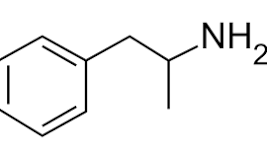
Draw the structure of methamphetamine
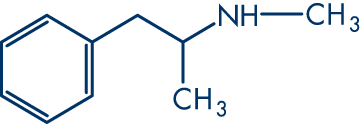
Draw the structure for methylene-dioxy-amphetamine
Draw the structure for methylene-dioxy-methamphetamine
Draw the structure for methylene-dioxy-ethylamphetamine
Under the Controlled Substances Act of 1970, what class do amphetamines fall under>
Schedule II
What receptors do amphetamine mediate activity through?
Dopaminergic and adrenergic receptors.
Name one synthetic route of methamphetamine
Phenyl-2-Propanone (P2P) + methylamine + aluminum foil + HgCl2 + C2H5OH → d-methamphetamine
Which amphetamine can be used for therapeutic purposes, and for treatments of what?
Dextroamphetamine can be used to treat narcolepsy and ADHD
The general effects of amphetamine and methamphetamine
Hyperstimulation, peripheral vasoconstriction, tachycardia, pupillary dilation, euphoria, intensification of feelings, convulsions, hyperthermia, behavioral changes
List at least three street names of methamphetamine
MA HCl
speed
crank
go
crystal
meth
ice
Which adulterants are added to amphetamine formulations? Name the role of each as well.
Sugars: add volume
Caffeine/phenylpropanolamine, ephedrine, pseudoephedrine: cheaper stimulants
Metabolic pathway of methamphetamine including structures
What plant is cannabis extracted from?
There are four:
sativa
indica
ruderralis
hybrid plants
What is the main factor that affects purity on Delta-9-tetrahyddrocannabinol in the plant?
Heat/humidity
More heat and less humidity means the leaves dry out more and concentrate the THC
In more humid areas, the concentration will be more dilute
What receptors are responsible for the effects of Delta-9-tetrahydrocannabinol in the central nervous system?
CB1 and CB2 receptors
What is the hysteresis effect?
Delta9-THC is rapidly absorbed and distributed to tissues. Initial changes in blood concentrations are out of phase with the physiological and behavioral changes.
Draw and name the endogenous compounds that regulate the endocannabinoid system

The complete metabolic pathway of delta9-Tetrahydrocannabinol to 11-OH-tetrahydrocannabinol and 11-nor-tetrahydrocannabinolic acid (with structures)
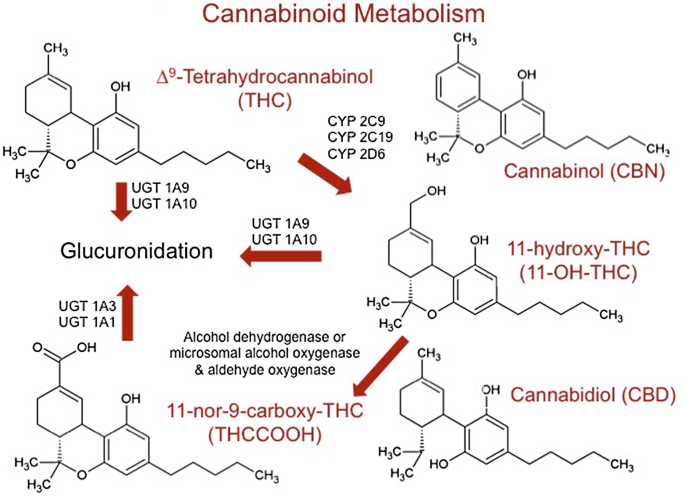
Are the metabolites of delta-9-tetrahydrocannabinol are active?
Yes, both 11-OH-THC and 11-nor-THCA are pharmacologically active metabolites of delta-9-THC that may contribute to its overall effects.
What is the disadvantage after per os use of cannabis product in terms of the bioavailable of Delta 9-tetrahydrocannabinol
The primary disadvantage is that it undergoes significant first-pass metabolism in the liver, which reduces the bioavailability of delta-9-THC and leads to variability in effects.
Name at least three behavioral effects of cannabis
Euphoria and relaxation, altered time perception, lack of concentration, impaired learning and memory, mood changes, and “drug-liking”
Name at least three acute toxic effects of cannabis
Increased heart rate, conjunctival diffusion, dry mouth and throat, increased appetite, CNS depression, neurocognitive deficit
What is the volume of distribution of Delta 9-tetrahydrocannabinol
4-14L/kg
How does the volume f distribution of Delta 9-tetrahydrocannabinol affect its partition in the human body
The volume of distribution of Delta 9-tetrahydrocannabinol, which ranges from 4-14L/kg, indicates how extensively the drug disperses into body tissues relative to the plasma. A higher volume suggests greater lipid solubility and a tendency to accumulate in fatty tissues, affecting its duration of action and potential psychoactive effects.
Which is the main tissue at which Delta 9-tetrahydrocannabinol is accumulated?
Fat
What is the elimination half-life for acute and long-term cannabis users?
acute: 20-57 hours
long-term: 3-13 days
What is the lipophilicity factor of Delta 9-tetrahydrocannabinol
LogP=6.97
How is the normalization of urine cannabinoid concentration calculated, and how can this be used to decide if a new episode of drug exposure has occurred?
Normalization of urine cannabinoid concentration is calculated by adjusting the cannabinoid levels for factors such as urine creatinine concentration. This helps determine if a new drug exposure has occurred by assessing relative changes in cannabinoid levels over time.
Accuracy/Bias
An estimate of systematic measurement error, calculated as the difference between the mean of several measurements under identical conditions, to a known “true” value. Often reported as a percent difference.
Precision
The measure of the closeness of agreement between a series of measurements obtained from multiple samplings of the same homogenous sample.
Biological fluid
Any liquid biological specimen that is typical pipetted for analysis
Fortified Matrix Sample
A blank matrix sample spiked with target analyte and/or internal standard using reference materials
Interferences
Non-targeted analyte signal in samples after the analysis of a positive sample
Carryover
The appearance of unintended analyte signal in samples after the analysis of a positive sample
Blank Matrix Sample
A biological fluid or tissue (or synthetic substitute) without target analyte or internal standard
Limit of Detection (LOD)
An estimate of the lowest concentration of an analyte in a sample that can be reliably measured with acceptable bias and precision
Lower Limit of Quantitation (LLOQ/Decision Limit)
An estimate of the lowest concentration of an analyte in a sample that can be reliably measured with acceptable bias and precision.
Stability
An analyte’s resistance to chemical change in a matrix under specific conditions for given time intervals
Tissues
Any solid biological specimen that is generally weighed for analysis
Reference Material
Material, sufficiently homogenous and stable with reference to specified properties, which have been established to be fit for its intended use in a measurement or in examination of nominal properties
Dilution Integrity
The process of assessing whether diluting a sample impacts the accuracy and precision of the measured concentration of an analyte.
Matrix effect
The influence of sample components other than the analyte (the substance being measured) on the analytical signal, potentially leading to inaccurate or inconsistent results
Calibration modeling
The process of ensuring a measuring intstrument or method produces accurate results
Specificity
The ability of an enzyme or assay to specifically recognize and interact with its target molecule or analyte, without reacting with other similar molecules
Selectivity
The ability of a process or reagent to preferentially react with or discriminate between different components in a mixture, leading to the formation of a specific product or the separation of specific components.
What are the two phases of method development
Instrumental and data acquisition/processing parameters
Sample preparation
The required validation parameter's for immunoassay screening methods
Limit of detection
Precision (at the decision point)
Processed sample stability (if applicable)
The required validation parameters for screening methods other than immunoassays
Interference studies
Limit of detection
Ionization suppression/enhancement for applicable techniques (LCMS)
Processed sample stability (if applicable)
The required validation parameters for quantitative methods
Bias
Calibration Model
Carryover
Interference Studies
Ionization suppression/enhancement (If applicable)
Limit of detection
Limit of quantitation
Precision
Dilution integrity (if applicable)
Processed sample stability (if applicable)
How to calculate Within-Run CV (%)
How to calcuate between run CV(%)
Acceptance criteria for %CV of bias and precision
The maximum acceptable bias shall be +/-20% at each concentration
For precision, %CV shall not exceed 20% at each concentration
The grand mean +/- two standard deviations of the low and high concentration pools shall not overlap with the mean of the decision point
Which are the calibration models used?
Simple linear regression model using the least squares method.
What is the least number of non-zero concentration calibrator samples that must be used to establish a calibration model
Four
How is LOD caluclated?
How is LOQ calculated?
LOQ = 10(Sy/Avgm)
How is Ion Suppression/Enhancement calculated?
Which detector favors ion suppression/enhancement
ESI and APCI
Draw the structure for Delta9THC
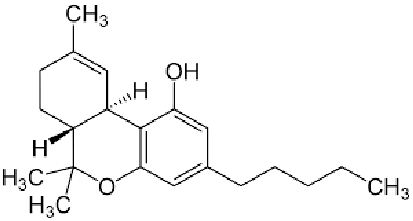
Draw the structure for 11-OH-THC
